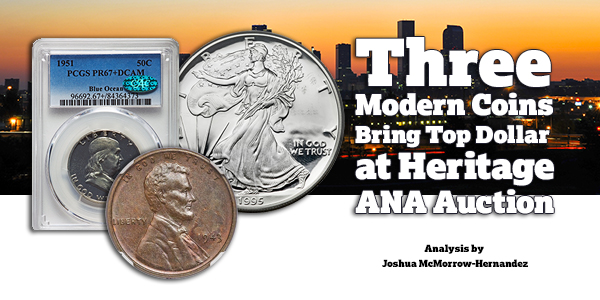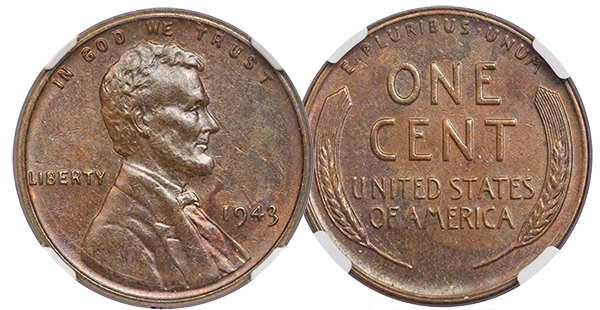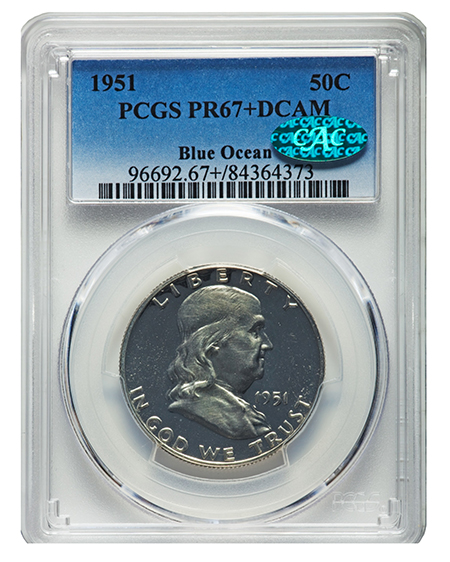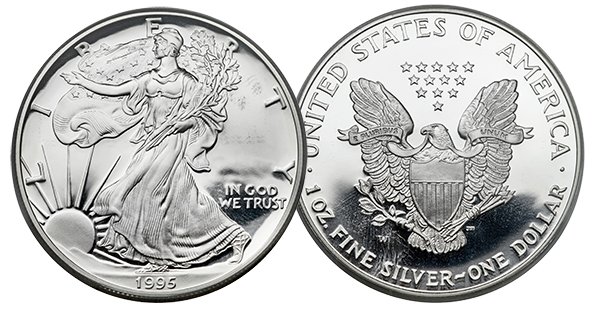
By Joshua McMorrow-Hernandez for CoinWeek.com ……
Modern coins took some of the top bids at the Heritage Auctions sale during the American Numismatic Association (ANA) World’s Fair of Money Show in Denver, Colorado, August 2-6, 2017. Nearly 99 percent of some 5,095 lots, including United States and world coins as well as paper currency, were sold during the five-day event exceeding $30.8 million. While the auction highlighted virtually everything from ancient Lydian staters to Series 2013 $20 Federal Reserve Note errors, the majority of the sale featured United States coinage, and modern coins figured prominently among the offerings.
Leading the sales for the United States coins was a modern off-metal one-cent error coin that has captured the imaginations of coin collectors for more than 70 years. We’re talking about the 1943 bronze Lincoln cent, and we will examine this and two other rare modern coins that commanded big bucks during the headlining Heritage event.
Lot #3899: 1943 NGC Bronze Lincoln Cent MS-62 BN

- Realized: $282,000 USD
The popular 1909-S VDB “penny” may well be the key date to the long-running Lincoln cent series. Yet for many collectors its far scarcer counterpart born of serendipitous circumstances, the 1943 Lincoln bronze cent, is the “holy grail”. And for the whopping price of $282,000 (including 17.5 percent buyer’s premium), one bidder at the Heritage event turned the hope of owning a 1943 bronze cent into a reality.
The 1943 bronze cent stands at the intersection of modern and classic coinage. Its birth came in the midst of World War II, a time when even basic commodities were being rationed–including copper, which the military needed for ammunitions. This spurred the creation of the 1943 steel cent, a then-unpopular one-year-only stand-in for the bronze cent. While more than one billion steel cents were made collectively at the Philadelphia, Denver and San Francisco Mints, a few bronze planchets were apparently still floating around in the United States Mint one-cent hoppers and were struck as 1943 pennies.
Coin dealer John J. Ford once explained his theory on how the 1943 bronze cents came to be in a PCGS article by Ed Reiter: “Presumably, some of the bronze planchets got hung up in the straps [of the galvanized planchet-feeding chutes] in December 1942, when production for that year ended. Then, when the steel blanks came along in early 1943, they pushed the bronze pieces along and they, too, were struck by the presses.”
While the exact circumstances behind the creation of the 1943 bronze cent have never been verified, the lore behind this classic error has a long history. The error coin made headlines as far back as the late 1940s, when Henry Ford promised a new car to the person who could give him a 1943 “copper” cent. By that point, the first reported discovery of a 1943 bronze cent had already been made, when a 14-year-old collector is said to have found a 1943-S specimen in circulation.
Today, the legendary error coin is a six-figure rarity that captures headlines whenever it crosses the auction block, and it regularly figures as the main subject of viral “$100,000 penny” social media posts. Countless Americans are aware of the coin, but most of them really know very little about it, with many non-numismatists often mistaking the inexpensive, common 1943 steel cent as the rare penny that will make them rich.
Indeed, anybody who has happened upon one of the perhaps two dozen or so 1943 bronze cents in existence has struck it rich. The 1943 bronze penny was already commanding outstanding premiums in the 1950s. Around 1959, the Greer Company of Los Angeles bought an example of the 1943 bronze cent for a reported $40,000 – a sum that seems substantially exaggerated given that even the 1804 Draped Bust dollar was selling for “only” around $10,000 at the time.
And $10,000 is exactly what Pennsylvania coin dealer Dave Berg paid for an Extremely Fine 1943 bronze cent at an ANA auction some two decades later in 1981.
According to the Numismatic Guaranty Corporation (NGC) population estimates, there is one 1943 “Brown” bronze cent grading higher than the specimen sold at the 2017 ANA summer show. With a highest grade of MS-63, nine total “Brown” Philadelphia specimens and 14 total across all three mints and grade combinations are reported by NGC. Professional Coin Grading Services (PCGS) states there are approximately 10 to 12 specimens of the 1943 bronze cent, including nine with “Brown” surfaces, one “Red/Brown”, and one “Red”. As for other 1943 bronze cents, PCGS reports one 1943-D bronze (MS-64 “Brown”), and five 1943-S bronze cents.
Lot #3993: 1951 PCGS CAC PR-67+ DCAM Franklin Half Dollar
- Realized: $82,250
Few classic United States 90-percent silver series are as short in duration or easy to complete by date and mintmark in the circulated grades than the Franklin half dollar. Minted from 1948 through 1963 and lacking any mintage-based keys, a basic set of Franklin half dollars is remarkably easy to assemble and can often be accomplished for prices little over spot for most specimens grading less than About Uncirculated.
 But assembling a collection of gem uncirculated or proof Franklin half dollars is another venture entirely. Registry set collectors, those who build sets composed of top-quality certified PCGS and NGC coins, vie for the best examples. And as any Franklin half dollar enthusiast will say, finding Deep Cameo proofs is like looking for hen’s teeth.
But assembling a collection of gem uncirculated or proof Franklin half dollars is another venture entirely. Registry set collectors, those who build sets composed of top-quality certified PCGS and NGC coins, vie for the best examples. And as any Franklin half dollar enthusiast will say, finding Deep Cameo proofs is like looking for hen’s teeth.
Yet according to Heritage, one 1951 Franklin half dollar that was offered at the summer ANA auction “could very well be the pinnacle of collecting for an advanced Franklin half dollar proof specialist.” The coin, once part of the Ocean Blue Collection, exhibits deep mirror fields and frosty white devices.
Heritage explains that die polishing lines on Franklin’s head as seen on this piece are “typically found on the best-contrasted examples of this elusive second-year [proof] issue.” Indeed, 1951 Franklin half dollars, like the first proof issue (1950) for the series, are usually found with little, if any, cameo contrast.
In short, this coin ranks among the very best proof Franklin half dollars, and population figures bear this out. PCGS lists this as the only Proof 67+ Deep Cameo specimen of the 1951 proof Franklin half dollar with none higher. Meanwhile, NGC states a population of six 1951 Franklin Proof half dollars grading Proof-67 “Ultra Cameo”, which is roughly equivalent adjective to the PCGS “Deep Cameo” designation. Setting the PCGS example apart is one significant fact: its green Certified Acceptance Corporation (CAC) sticker declaring this coin’s superior eye appeal and overall quality.
Lot #4239: 1995-W PCGS PR-70 Deep Cameo American Silver Eagle
- Realized: $16,450
Among modern rarities, few can compare to the exquisite perfection of the 1995-W American Silver Eagle. It’s a scarce coin with a genuinely low mintage, born a limited-edition bonus available only to those who purchased the American Eagle 10th Anniversary Set – the 10th annual proof set installment of the American Eagle bullion coin series that began in 1986. The proof set includes 1995-W American Gold Eagles in $50 one-ounce, $25 half-ounce, $10 quarter-ounce, and $5 tenth-ounce denominations alongside the $1 Silver Eagle.
In 1995, when gold prices averaged $387 per ounce, one could buy the five-coin 1995 American Eagle set for $999 and receive the 1995-W American Silver Eagle in the set free of charge as a 10th anniversary gift. The American Silver Eagle was regarded as a bonus because, ordinarily, the American Eagle proof set includes only the four gold denominations.
Of a maximum mintage of 45,000 sets, only 30,125 were sold. Thus, that’s the effective mintage of the 1995-W American Silver Eagle, which in most cases sells for approximately $4,000 for a typical proof example.
One Proof-70 Deep Cameo specimen commanded more than four times that amount at the summer ANA heritage sale. While the common assumption among many hobbyists these days is that American Silver Eagles are plentiful in Proof-70, that isn’t always the case – especially when discussing the 1995-W.

PCGS lists a population of 210 examples for the 1995-W in Proof-70 Deep Cameo, a figure that has increased in recent years. Still, considering the strong demand for Proof-70 specimens (especially among registry set collectors), a population of 210 pieces is relatively tiny.
Prices for 1995-W Proof-70 Deep Cameo American Silver Eagles have been all over the board, even when counting only PCGS-certified examples sold during the year 2017; in March one example was sold by Stack’s Bowers for $15,275, and just one month later, in April, another example was sold by Heritage for $22,326.18.
There’s a certain charm to the 1995-W American Silver Eagle in the context of its rarity. While the coin is squarely a representative of the modern era, struck as part of the American Eagle bullion program, in other ways it’s a throwback to an earlier period for the U.S. Mint. Notably, it was released three years before the Mint’s catalog went online in 1998. That means collectors had to buy the 1995-W American Eagle set the “old-fashioned way”: by placing an order by phone or through postal mail.
What’s more, falling nearly 15,000 pieces short of its maximum mintage of 45,000, it was by no means a five-minute sellout as is common with today’s low-mintage online offerings.
Could such a genuine rarity be created today? That’s hard to say. But one thing is clear: collectors who had the ability to pay $999 for the opportunity to buy a 1995-W American Eagle Anniversary Set from the United States Mint certainly hit the jackpot, and they’re reaping the monetary rewards today.




